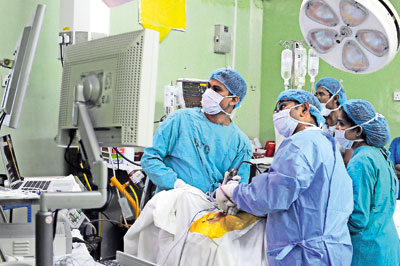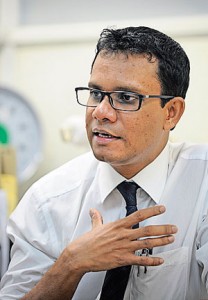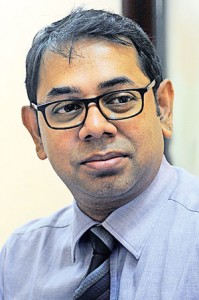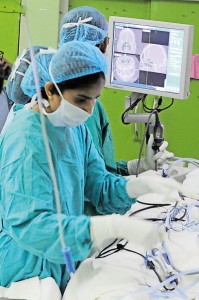News
Into the brain through the nostrils

Two pairs of hands at work – Dr. Daminda Dumingoarachchi and Dr. Stravinsky Perera performing the operation together. Pix by Amila Gamage
There is purposeful concentration, while soft and soothing music plays in the background, as different teams of doctors and nurses, scrub up and move around Operating Theatre (OT) C of the Anuradhapura Teaching Hospital.
On the operating table is a pretty middle-aged woman, but something seems unusual with her face – it seems unduly large, with the nose being pronounced.
While Consultant Anaesthetist Dr. Ayesha Abeyratne and her team are preparing the patient for surgery, two Consultants from different specialties are studying the Magnetic Resonance Imaging pictures. They are Consultant Ear, Nose and Throat (ENT) Surgeon, Dr. Daminda Dumingoarachchi who is also a Head and Neck Surgeon and Consultant Neurosurgeon, Dr. Stravinsky Perera. Although not present in the OT that day, Consultant ENT Surgeon Dr. Upul Abeysundara is also very much a part of this pioneering work in Sri Lanka.
It is a Monday morning and we too are in OT clothes and masks privy to viewing an operation not done anywhere else in the state sector, except the Anuradhapura Hospital.
Accessing the patient’s brain through the nostrils is what the ENT and Neuro Teams will do in one of many trailblazing procedures, while the Anaesthetic Team will ensure that her vitals are stable and the able theatre nursing staff will play their part.
Image-guided (navigation-assisted) endoscopic trans-nasal trans-sphenoidal pituitary surgery is what we are about to view being performed in the country only since October this year. For, the 38-year-old patient lying inert on the operating table has a tumour just above her pituitary gland, between the optic nerves and the carotid arteries, making it a difficult operation-site to access. (The pea-size pituitary gland is dubbed the ‘master gland’ as it produces many hormones for the whole body, while also stimulating other glands to produce other hormones.)
Dr. Dumingoarachchi points out that the ENT navigator which the Anuradhapura Hospital was provided with recently, is like the GPS system of the brain which shows this vital organ’s architecture.
Dr. Perera explains that the patient has acromegaly, the abnormal production of growth hormones from the pituitary, causing a large nose and big hands etc. This is while it also causes an abnormal reduction in other hormones, affecting the functioning of the whole body. The enlarged pituitary is also compressing the main artery of the brain. A major issue is that the patient’s vision is being affected and if the tumour is not decompressed, she would go blind.

Dr. Daminda Dumingoarachchi
Matters also seem complicated as the patient had undergone ‘conventional’ brain surgery to remove an earlier tumour in the same area in 2009 in another hospital, but some parts had been left behind because it was complex surgery and the slightest slip of the scalpel could cause serious harm.
We watch in fascination as the surgical teams discuss how the tumour has grown around the right carotid artery making it a challenging procedure and is pressing down (compressing) on the brain.
This pituitary macroadenoma with acute intra-tumoural haemorrhage (bleeding) is “big” — 5X3.8X3.5cms, says Dr. Perera, adding that laterally, the lesion extends to the right cavernous sinus encircling almost the full circumference of the cavernous part of the right carotid artery. The left carotid artery is spared.
Super-imposing the patient’s Computed Tomography (CT) scan with images of the real anatomy, the ‘registration’ takes place for this ‘re-do’ surgery, as he explains that the anatomy is distorted after her previous surgery done seven years ago.
In the freezing OT, we don’t feel the time passing as both the Neurosurgeon and the ENT Surgeon attend to their tasks, two pairs of hands working in tandem, not looking down at the patient but up at the two screens, while navigating the pathways through the nostrils to the brain.
Usually, such a large tumour above the pituitary gland will entail open-skull surgery, with the brain having to be retracted (drawn away from the site of the operation) to gain access to the tumour, we learn. While the dangers of such surgery are numerous, the patient also has to spend a long time in the Intensive Care Unit (ICU) in the recovery phase.
With the frontiers of medicine pushed back more and more, Dr. Dumingoarachchi says that now skull-base structures can be approached through the nose, ear and throat. “Such surgery involves dealing with pathologies located on the under-surface of the brain, with Neurosurgeons and ENT Surgeons together accessing the skull-base more easily through the nose, ear and throat.”
Pointing out that these trans-nasal and trans-labyrinthine approaches to the skull-base will help bring down the rate of revision neurosurgeries and cut down the time that the patient will have to spend in the ICU post-operatively, he adds that the patients can go back home sooner without complications and be productive more quickly. Currently, some patients even go to other countries to get these services.
With the Health Ministry providing a high definition 3-chip endoscopic camera system, an anterior skull-base set, a micro-debrider and an ENT navigator, vast strides have been made at the Anuradhapura Hospital. They include:

Dr. Stravinsky Perera
* Anterior skull-base surgeries — Endoscopic anterior skull-base surgeries, starting with pituitary surgeries using the endoscopic trans-sphenoidal approach for the first time in Sri Lanka. The latest addition, in October this year, is image-guidance (navigation).
The other procedures include cranio-pharyngioma, olfactory neuroblastoma, cerebrospinal fluid leak repairs, para-nasal sinus cancer resections and odontoid (cervical spine) decompression.
The advantages of this approach include a better field of view and ease of doing revision surgery if required, while leaving no external scars.
Nasal polyposis is also now being managed by image-guided powered full house functional endoscopic sinus surgeries, resulting in the reduction of the recurrence rate. This also cuts down revision surgeries.
* Lateral skull-base surgeries – Throughmicroscopic lateral skull-base surgery, trans-labyrinthine acoustic neuromas have been removed. With direct access to these eighth-nerve tumours, no brain retraction has been necessitated, resulting in less post-operative morbidity. The whole tumour can be removed while preserving the seventh cranial nerve, as the hospital has also been given intra-operative cranial nerve monitoring facilities.
Paying tribute to Dr. Palitha Mahipala, Director-General of Health Services, for making the navigator available to them, Dr. Dumingoarachchi also expresses appreciation to the Deputy Director-General (DDG) of the Biomedical Division, Muditha Jayathilake, Biomedical Engineers Apsara and Kumuduni and DDG Dr. Lakshmi Somatunga for all their support.

An efficient theatre nurse prepares the instruments just before the surgery
| Treating neurological disorders of the ear Another major advancement in the treatment being provided by the ENT Unit of the Anuradhapura Hospital is neurotology – the treatment of neurological disorders of the ear. “Neurotology involves the inner ear and its neural connections located at the base of the skull. Under neurotology services, ENT Surgeons along with Neurologists and Audiologists work together to diagnose and manage ‘balance’ and ‘hearing’ disorders,” says Consultant ENT Surgeon Dr. Daminda Dumingoarachchi. The record of the Anuradhapura ENT Unit is impressive in other spheres as well. Being provided equipment to expand its audiology service by adding neonatal hearing screening, the audiology laboratory has been able to clear the long waiting lists by reducing the screening time from 45 minutes per child to five minutes. It has plans to implement a universal hearing screening programme at the hospital, next year. Meanwhile, under the ‘balance’ service, the unit provides physiotherapists with training in vestibular rehabilitation. However, Dr. Dumingoarachchi laments that the unit is facing major issues with regard to space availability for audiology and vestibular assessment. Currently, the Sunday Times sees, balance assessment being performed in a temporary, partitioned area in the ENT clinic corridor. What the unit needs urgently is a separate audio-vestibular laboratory attached to the ENT clinic to accommodate neonates, mothers and patients with balance and hearing disorders. “We need only an additional room close to the ENT clinic, along with a nurse and a second audiology technician,” he says. Pointing out that the unit has the potential to implement cochlear implant surgery for the benefit of children in the North Central Province next year, Dr. Dumingoarachchi adds that what they also need is adequate operating-theatre time and more Anaesthetists. The ‘usual’ and ‘objective’ hearing (audiological) tests performed at the unit include: n Audiometry – Seated in a sound-proof room, the patient wears ear-phones through which are delivered tones at different pitches and levels. The patient is requested to press a button whenever he/she hears the tones and the response is recorded to determine his/her hearing. n Tympanometry – A small ear-piece is used to cause pressure and play a sound in the ear canal. This test can determine whether there are any problems in the middle ear. The same test may be used to check out acoustic reflexes, the reflex of middle-ear muscles to pressure and loud sound. n Electrophysiological Tests related to hearing – A sound is given out and the cochlear (hearing) and cochlear-nerve functions as well as the brain-stem function are checked out. These tests include Otoacoustic Emissions (OAEs) as a screening and a diagnostic test; Electrocochleography (ECoG); Auditory Brain-Stem Response (ABR) as a screening and a diagnostic test; and Auditory Steady State Response (ASSR). (Please see the Cover Page of MediScene) |

